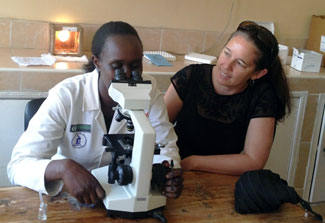Testing curbs malaria drug misuse in Kenya
January / February 2016 | Volume 15, Issue 1

Photo courtesy of Dr. Wendy Prudhomme O'Meara
Former Fogarty scientist Dr. Wendy Prudhomme O'Meara (right)
and a Kenyan trainee set up a new microscope for malaria
diagnoses to help curb unwarranted use of frontline drugs.
By Cathy Kristiansen
A Kenyan mother is worried that her lethargic, feverish toddler has malaria and rushes to the clinic. A diagnostic test might show the disease is absent, but neither the mother nor clinic wants to pay for it, so the child receives antimalarial medicine anyway.
Treating malaria where none exists can help the parasite build drug resistance. This has already occurred in Southeast Asia against the world's most potent antimalarial compound - artemisinin - and scientists predict resistance could soon strike Africa. Alarmed, Dr. Wendy Prudhomme O'Meara devised a study to discourage unwarranted use of malaria medicines in Kenya and recently described her work in the journal BMC Medicine. A former Fogarty staff scientist, she is now funded by NIH's National Institute of Allergy and Infectious Diseases (NIAID) and holds posts at both Duke and Kenya's Moi University.
"All of our frontline therapies include artemisinin," Prudhomme O'Meara said in a recent presentation to Fogarty. "The potential impact of artemisinin resistance is huge. We don't really have any other drugs in the pipeline, so if we lose this one, it's a serious problem."
In Kenya, artemisinin-based therapies are subsidized, to help everyone with malaria access effective treatment, but diagnostic tests are not covered. Government data show the population received 20 million artemisinin-containing treatments in 2009, compared with only 9 million confirmed malaria cases. Prudhomme O'Meara's study examined whether offering financial incentives to health care facilities would increase use of malaria diagnostic testing and curb prescriptions for patients with a negative finding.
She and her team enrolled 18 health care facilities that were evenly split between low- and high-malarial areas, with half as controls. They established seven performance indicators that counted toward the incentives, including records of patient identification numbers, quality lab diagnoses and clinician adherence to lab findings. The team held a workshop to refresh laboratory skills in microscopy - the primary diagnostic tool - and reread each sample result to monitor overall accuracy and further train technicians with false findings.
The one-year intervention covered nearly 15,000 patient encounters. Antimalarial prescriptions to those with a negative test result dropped substantially, from 22 to 7 percent. Prescriptions to untested patients also fell dramatically, from 41 to 26 percent.
During the study, incentive payments averaged $650 per quarter, about half the potential amount available. Facilities used the money primarily for equipment and supplies, including delivery beds, steam sterilizers and lab reagents, and also on building needs, such as security grills and plumbing repairs. "It took them a few quarters to get organized, then they really excelled," Prudhomme O'Meara explained. "The incentive also emphasized the teamwork involved in properly treating malaria, which includes record-keeping, pharmacy, lab and physician, all working together."
She said her team chose a facility incentive plan because previous efforts targeting individual health care providers in developing countries have produced little sustained change. If successful over the long run, this novel approach could not only protect the power of malaria drugs, but also rechannel some government funds previously spent on drugs into improving health infrastructure.
Although half of Kenyans obtain free malaria treatment in clinics, others buy their drugs directly from local stores. Recent retail price hikes for first-line malaria drugs made them more expensive than a diagnostic test, so the team devised a follow-up intervention targeting the informal health sector. The researchers are offering potential patients a voucher to pay for treatment based on a positive malaria diagnostic test result, which they hope will spur testing.
Successful programs could be expanded, Prudhomme O'Meara said. "We showed that these facility-directed incentives could be an important and potentially sustainable type of behavior-change intervention," she noted. "It is alarming that the uninfected patient is being treated with antimalarials, but even more concerning is for future patients for whom this drug is being compromised."
More Information
To view Adobe PDF files,
download current, free accessible plug-ins from Adobe's website.